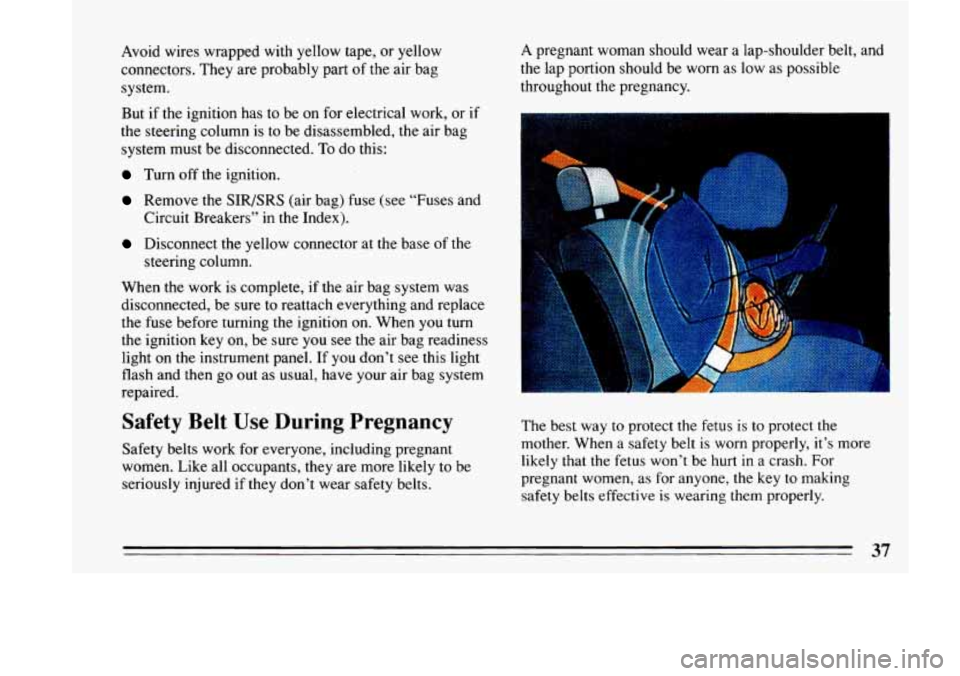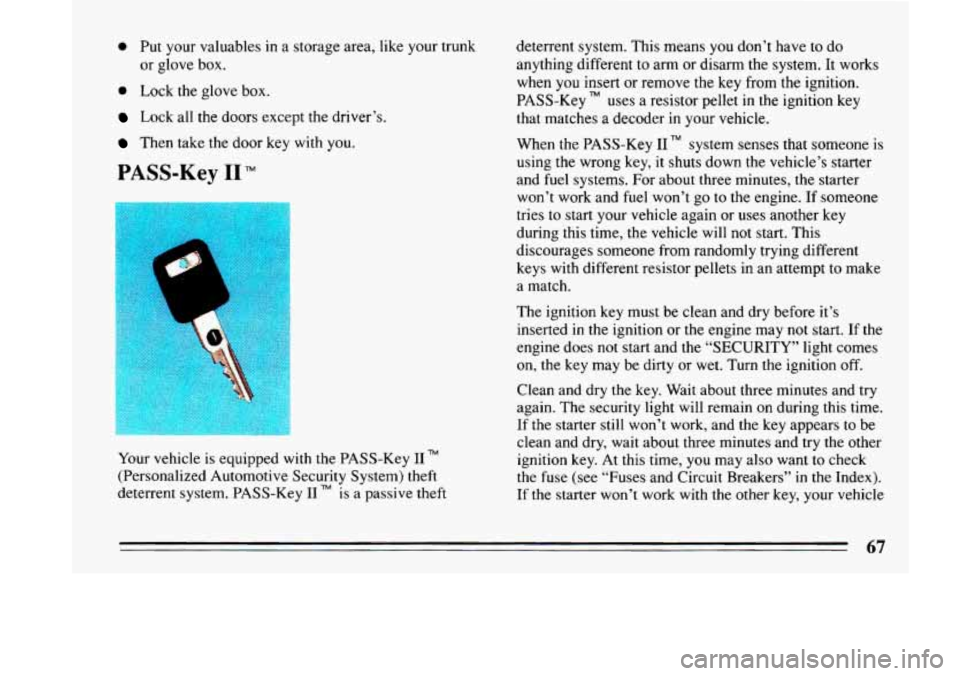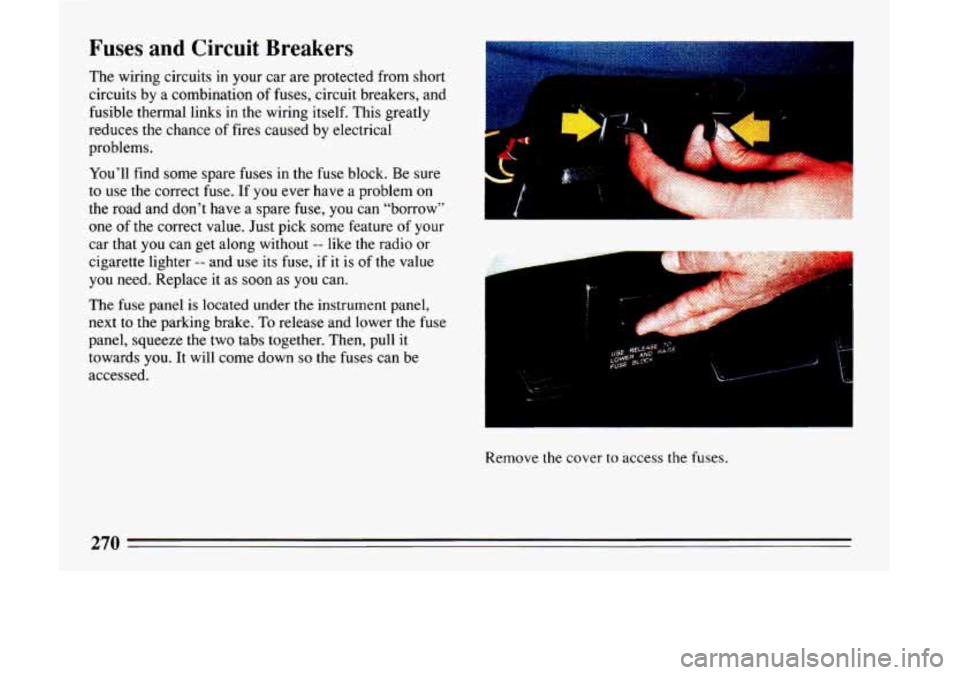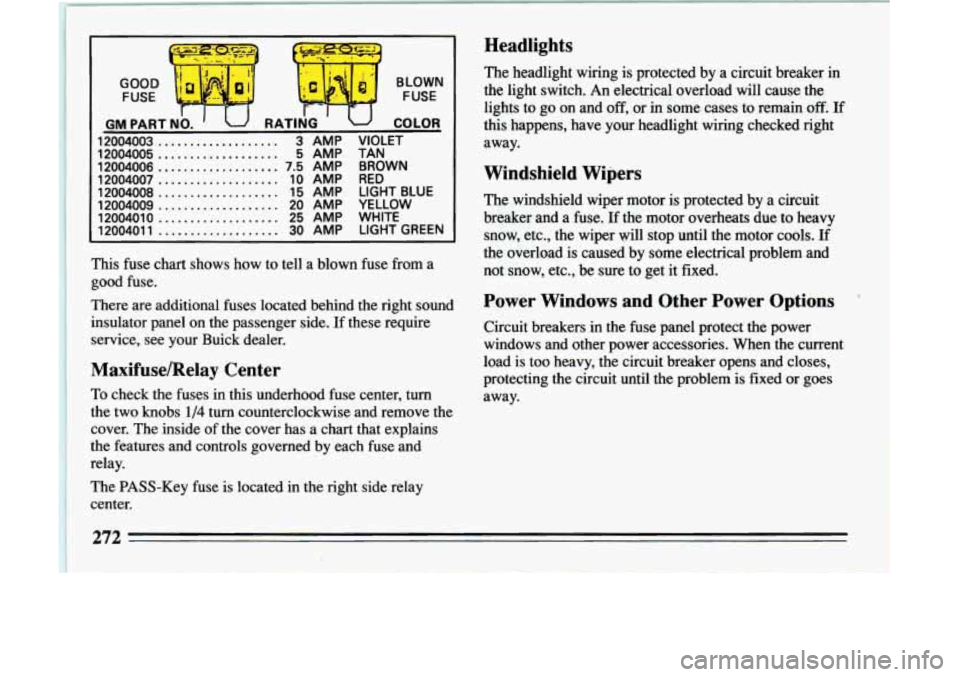1993 BUICK LESABRE fuses
[x] Cancel search: fusesPage 39 of 324

Avoid wires wrapped with yellow tape, or yellow
connectors. They are probably part of the air bag
system.
But if the ignition has to be on for electrical work, or if
the steering column is to be disassembled, the air bag
system must be disconnected.
To do this:
Turn off the ignition.
Remove the SIR/SRS (air bag) fuse (see “Fuses and
Circuit Breakers” in the Index).
Disconnect the yellow connector at the base of the
When the work is complete, if the air bag system was
disconnected, be sure to reattach everything and replace
the fuse before turning the ignition on. When you
turn
the ignition key on, be sure you see the air bag readiness
light on the instrument panel. If
you don’t see this light
flash and then go out as usual, have your air bag system
repaired. steering
column.
Safety Belt Use During Pregnancy
Safety belts work for everyone, including pregnant
women. Like all occupants, they are more likely to be
seriously injured if they don’t wear safety belts. A
pregnant woman should wear a lap-shoulder belt, and
the lap portion should be worn
as low as possible
throughout the pregnancy.
7
The best way to protect the fetus is to protect the
mother. When
a safety belt is worn properly, it’s more
likely that the fetus won’t be
hurt in a crash. For
pregnant women, as for anyone, the key to making
safety belts effective is wearing them properly.
37
Page 69 of 324

e Put your valuables in a storage area, like your trunk
0 Lock the glove box.
Lock all the doors except the driver’s.
Then take the door key with you.
or glove box.
PASS-Key I1 TM
Your vehicle is equipped with the PASS-Key I1 TM
(Personalized Automotive Security System) theft
deterrent system. PASS-Key I1
TM is a passive theft deterrent system.
This means you don’t have to do
anything different
to arm or disarm the system. It works
when you insert or remove the key from the ignition.
PASS-Key uses a resistor pellet in the ignition key
that matches
a decoder in your vehicle.
When the PASS-Key I1
TM system senses that someone is
using the wrong key, it
shuts down the vehicle’s starter
and fuel systems. For about three minutes, the starter
won’t work and
fuel won’t go to the engine. If someone
tries to start your vehicle again or uses another key
during this time, the vehicle will not start. This
discourages someone from randomly trying different
keys with different resistor pellets in an attempt to make
a match.
The ignition key must be clean and dry before it’s
inserted in the ignition or the engine may not start.
If the
engine does not start and the “SECURITY” light comes
on, the key may be dirty or wet. Turn the ignition off.
Clean and dry the key. Wait about three minutes and try
again. The security light will remain on during this time.
If the starter still won’t work, and the key appears to be
clean and dry, wait about three minutes and try the other
ignition key. At this time, you may also want to check
the
fuse (see “Fuses and Circuit Breakers” in the Index).
If the starter won’t work with the other key, your vehicle
67
Page 88 of 324

A green arrow on the
instrument panel will flash
in the direction
of the turn
or lane change. If
you have
a trailer towing option with added wiring for
the trailer lights, a different turn signal flasher is used.
With this flasher installed, the signal indicator will flash
even if a turn signal bulb is burned out. Check the front
and rear
turn signal lights regularly to make sure they
are working.
Operation of Lights
To signal a lane change, just raise or lower the lever
until the green arrow starts to flash. Hold
it there until
you complete your lane change. The lever will return by
itself when you release it.
As you signal a turn or a lane change, if the arrows don’t
flash
but just stay on, a signal bulb may be burned out
and other drivers won’t see your turn signal.
If a bulb is burned out, replace it
to help avoid an
accident. If the green arrows don’t
go on at all when you
signal a turn; check the fuse (see “Fuses” in the Index)
and for burned-out bulbs. Although your vehicle’s lighting system
(headlamps,
parking lamps, fog lamps, side marker lamps and
taillamps) meet all applicable Federal lighting
requirements, certain States and Provinces may apply
their own lighting regulations that may require special
attention before you operate
these lamps. For example,
Page 231 of 324

@ Part 6 Service & Appearance Lare
Here you will find information about the care of your Buick . This part begins with service and fuel information. and
then it shows how to check important fluid and lubricant level\
s
. There is also technical information about your
vehicle. and a section devoted to its appearance care .
Part 6 includes:
ServiceTips
......................................................................
Fuel ........................................................................\
.....
HoodRelease .....................................................................
Engineoil ....................................................................... \
AirFilter ........................................................................\
.
Automatic Transaxle Fluid ............................................................
Enginecoolant ....................................................................
Power Steering Fluid ...............................................................
Windshield Washer Fluid ............................................................
Brakes ........................................................................\
...
Battery ........................................................................\
..
BulbReplacement .................................................................
Tires ........................................................................\
.....
Appearancecare ..................................................................
Vehicle Identification Number (VIN) ..................................................
FusesandCircuitBreake ............................................................
Capacities and Specifications .........................................................
LoadingYourVehicle ...............................................................
230
231
234
236
240
241
243
246 247
248
249
250
253
255
262
269
270
275
229
Page 272 of 324

Fuses and Circuit Breakers
The wiring circuits in your car are protected from short
circuits by a combination
of fuses, circuit breakers, and
fusible thermal links
in the wiring itself. This greatly
reduces the chance
of fires caused by electrical
problems.
You’ll find some spare
fuses in the fuse block. Be sure
to use the correct fuse.
If you ever have a problem on
the road and don’t have a spare fuse,
you can “borrow”
one
of the correct value. Just pick some feature of your
car that
you can get along without -- like the radio or
cigarette lighter
-- and use its fuse, if it is of the value
you need. Replace it as soon as you can.
The fuse panel
is located under the instrument panel,
next to the parking brake.
To release and lower the fuse
panel, squeeze the two tabs together. Then, pull it
towards you.
It will come down so the fuses can be
accessed.
c m
k
Remove the cover to access the fuses.
270
Page 274 of 324

-..
I 7
GOOD FUSE
f7-7 6
FUSE
GM PART NO. RATING COLOR
IIU
12004003 ................... 3 AMP VIOLET
12004005
................... 5 AMP TAN
12004006
................... 7.5 AMP BROWN
12004007
................... 10 AMP RED
12004008
................... 15 AMP LIGHT BLUE
12004009
................... 20 AMP YELLOW
12004010
................... 25 AMP WHITE
12004011
................... 30 AMP LIGHT GREEN
This fuse chart shows how to tell a blown fuse from a
good fuse.
There are additional fuses located behind the right sound
insulator panel on the passenger side. If these require service, see your Buick dealer.
Maxifuse/Relay Center
To check the fuses in this underhood fuse center, turn
the two knobs 1/4 turn counterclockwise and remove the
cover. The inside
of the cover has a chart that explains
the features and controls governed by each fuse and
relay.
The PASS-Key fuse is located in the right side relay center.
Headlights
The headlight wiring is protected by a circuit breaker in
the light switch. An electrical overload will cause the
lights to go on and
off, or in some cases to remain off. If
this happens, have your headlight wiring checked right
away.
Windshield Wipers
The windshield wiper motor is protected by a circuit
breaker and
a fuse. If the motor overheats due to heavy
snow, etc., the wiper will stop until the motor cools. If
the overload is caused by
some electrical problem and
not snow, etc., be sure to get it fixed.
Power Windows and Other Power Options
Circuit breakers in the fuse panel protect the power
windows and other power accessories. When the.current
load is too heavy, the circuit breaker opens and closes,
protecting the circuit until the problem is fixed or goes
away.
272
Page 310 of 324

Electric Outside Mirror Control .................... 100
Electrical Equipment. Adding
.................. 128. 269
Emergencies. Braking
............................ 163
Emergencies on the Road
.......................... 195
Emergencies. Steering in
......... ; ................ 164
Emergency Starting. Dead Battery
................... 198
Emergency Wrecker Towing
....................... 203
Engine Energy Conserving
Oil ............................ 237
Block Heater
.............................. 72. 239
Coolant
................................. 21 1. 243
Coolant Temperature Warning Light
.............. 110
Exhaust
...................................... 81
Identification
................................. 269
Oil
......................................... 236
Oil Additives
................................. 239
Oil Life Monitor
.............................. 114
Oil Pressure Warning Light
..................... 112
Oil. When to Change
...................... 239. 277
Overheating
.................................. 208
Starting
...................................... 70
Warning Light. Need for Service
................. 111
Ethanol in Gasoline
.............................. 231
Expectant Mothers. Use of Safety Belts
............... 37
Explanation of Scheduled Services
.................. 286
Expressway Driving
.............................. 176
Extender. Safety Belt
.............................. 55
Exterior Appearance ............................. 265 Fasteners.
Replacement
.......................... 230
Features and Controls
............................. 57
Fetus. Risk to
.. From Safety Belt Use ................ 37
Filling Your Fuel Tank
............................ 233
Filter. Oil
...................................... 275
Finish Care
..................................... 266
Finish Damage
.................................. 267
First Gear. When to Use
............................ 75
Flat Tire
....................................... 216
Flooded Engine. Starting a
.......................... 70
Fluid
Capacities
................................... 275
Brake
....................................... 248
Power Steering
........... ; ................... 246
Transaxle/Transmission
........................ 241
Windshield Washer
............................ 247
Fluids and Lubricants Recommended
................ 293
FM Stereo Radio Reception
........................ 127
Fog. Driving
in .................................. 173
Francais. Guide En
................................. 2
Freedom Battery
................................. 249
Freeway Driving
................................ 176
French LanguageManual
........................... 2
Front Brake Disc Wear Indicators
................... 162
Front Towing Hook-Ups
.......................... 206
Fuel
.......................................... 231
Fuel Gage
...................................... 106
Fuel Tank. Filling Your
........................... 233
Fuses and Circuit Breakers
........................ 270
Fuseusage ..................................... 271
Foreign Operation
............................... 232
308